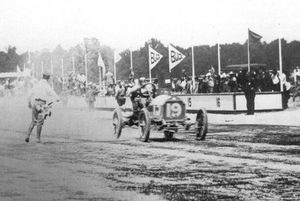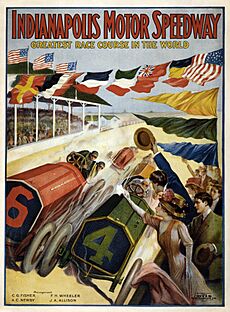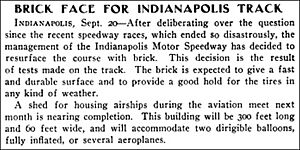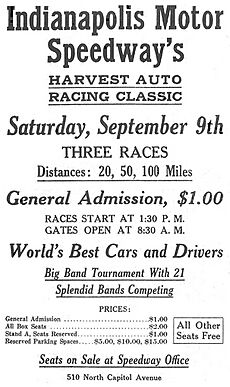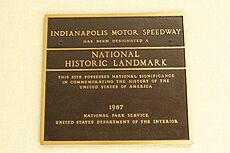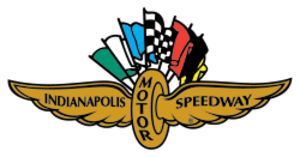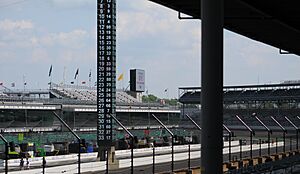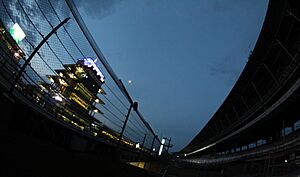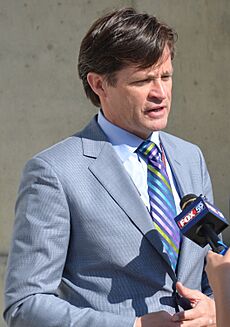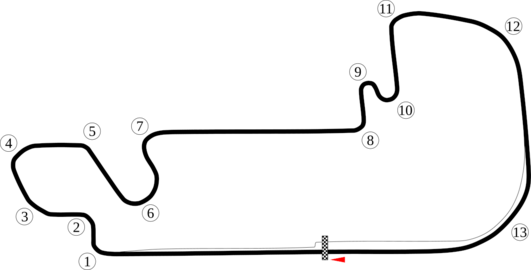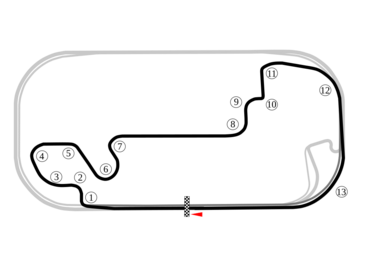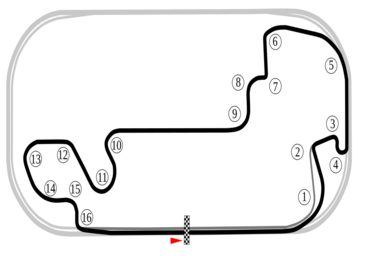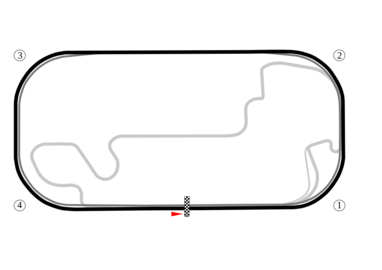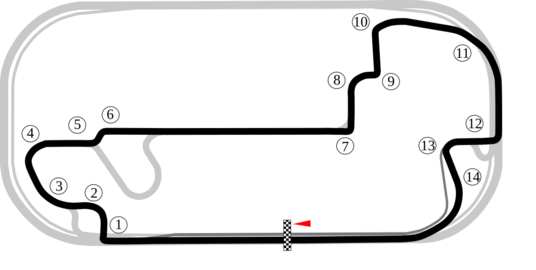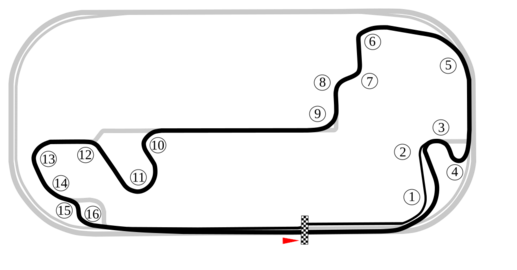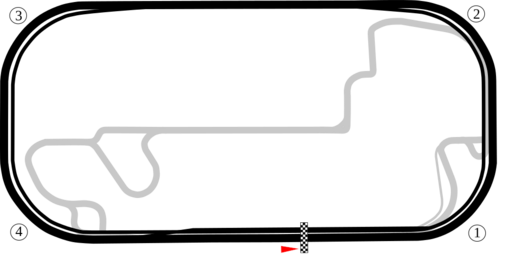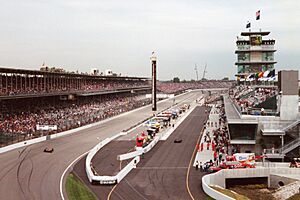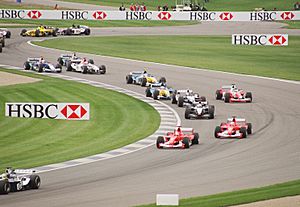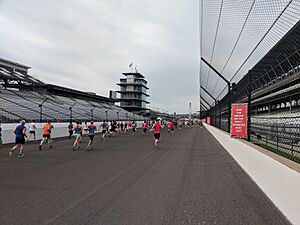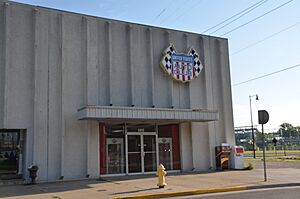Indianapolis Motor Speedway facts for kids
| The "Brickyard" IMS |
|
|---|---|
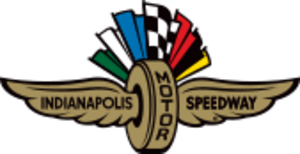
|
|
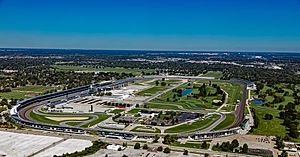
Indianapolis Motor Speedway aerial in 2016
|
|
| Location | Speedway, Indiana |
| Coordinates | 39°47′54″N 86°13′58″W / 39.79833°N 86.23278°W |
| Capacity | 257,325 (permanent seats) – 400,000 grand total |
| Owner | Penske Entertainment Group (2020–present) Hulman & Company (1945–2019) Eddie Rickenbacker (1927–1945) Carl G. Fisher (1909–1927) |
| Operator | IMS, LLC (subsidiary of Penske Entertainment Group) |
| Address | 4790 West 16th Street |
| Broke ground | March 15, 1909 |
| Opened | August 14, 1909 |
| Construction cost | US$3 million ($86 million 2021 dollars) |
| Architect | Carl G. Fisher, James A. Allison, Frank H. Wheeler, Arthur C. Newby |
| Major events | Current:
Future:
Former:
|
| Surface | Asphalt and brick (start-finish line) |
| Length | 2.500 mi (4.023 km) |
| Turns | 4 |
| Banking | Turns: 9.2° Straights: 0° |
| Race lap record | 0:38.119 ( |
Grand Prix Road Course (2014–present) 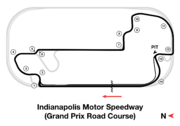 |
|
| Surface | Asphalt and brick (start-finish line) |
| Length | 2.439 mi (3.925 km) |
| Turns | 14 |
| Race lap record | 1:09.3888 ( |
Modified Motorcycle Course (2014–present) 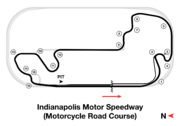 |
|
| Surface | Asphalt and brick |
| Length | 2.591 mi (4.170 km) |
| Turns | 16 |
| Race lap record | 1:32.625 ( |
| SCCA Runoffs Road Course (2014–present) | |
| Surface | Asphalt and brick (start-finish line) |
| Length | 2.589 mi (4.166 km) |
| Turns | 15 |
| Race lap record | 1:30.650 ( |
| Original Motorcycle Course (2008–2013) | |
| Surface | Asphalt and brick |
| Length | 2.621 mi (4.218 km) |
| Turns | 16 |
| Race lap record | 1:39.044 ( |
| Grand Prix Road Course (2008–2013) | |
| Surface | Asphalt and brick (start-finish line) |
| Length | 2.534 mi (4.078 km) |
| Turns | 13 |
| Race lap record | 1:22.191 ( |
| Grand Prix Road Course (2000–2007) | |
| Surface | Asphalt and brick (start-finish line) |
| Length | 2.605 mi (4.192 km) |
| Turns | 13 |
| Race lap record | 1:10.399 ( |
|
Indianapolis Motor Speedway
|
|

The Indianapolis Motor Speedway under construction
|
|
| Lua error in Module:Location_map at line 420: attempt to index field 'wikibase' (a nil value). | |
| Location | 4790 W. 16th St., Speedway, Indiana |
| Built | 1909 |
| Architect | Andrews, Park Taliaferro |
| Architectural style | Motor racing circuit |
| NRHP reference No. | 75000044 |
| Significant dates | |
| Added to NRHP | March 7, 1975 |
| Designated NHLD | February 27, 1987 |
The Indianapolis Motor Speedway is a famous place for motor racing in Speedway, Indiana, which is a town near Indianapolis. It is known as the home of the exciting Indianapolis 500 race and the Brickyard 400. It also used to host big events like the United States Grand Prix for Formula One cars and the Indianapolis motorcycle Grand Prix for motorcycles.
This amazing track was built in 1909. It was one of the first special tracks made for racing with sloped turns. It was also the very first track to be called a "speedway." The idea came from a smart businessman named Carl G. Fisher. He wanted a place where new cars could be tested safely and effectively. The Indianapolis Motor Speedway is the third oldest permanent car race track in the world. It can hold a huge number of fans, with over 257,000 permanent seats, making it one of the largest sports venues anywhere!
The main track is a 2.5-mile (4.023 km) oval shape. It has stayed almost the same since it was built. There are two long straight sections and four turns that are all the same. These turns have a slight slope, or "banking," of about 9 degrees.
Over the years, new track layouts have been added inside the oval. These "road courses" are used for different types of races. The entire area has grown to cover more than 559 acres (2.26 km²). The Speedway is so important that it was named a National Historic Landmark in 1987.
Besides the big races, the Speedway also has the Indianapolis Motor Speedway Museum. This museum opened in 1956 and shows off many famous race cars and racing history. There's even a golf course called Brickyard Crossing, with some holes inside the track! The track is often called "The Brickyard" because of its original surface. Many people call it the "Racing Capital of the World."
Today, the Speedway is owned by Penske Entertainment Group. This company bought the track in 2020 from the Hulman family, who had owned it for many years.
Contents
History of the Indianapolis Motor Speedway
Building a Racing Dream
The idea for the Speedway came from Carl G. Fisher in 1905. He saw how dangerous early car races were on regular roads and horse tracks. Fisher wanted a safe, smooth track where car makers could test their new vehicles. He imagined a large, circular track where cars could reach high speeds.
Fisher visited the Brooklands track in England in 1907. Seeing its sloped turns made him even more determined. He believed Indianapolis, with its many car factories, was the perfect spot for "the world's greatest racetrack."
Fisher found a large farm outside Indianapolis. In 1908, he teamed up with three other businessmen: James A. Allison, Arthur C. Newby, and Frank H. Wheeler. Together, they bought the land and started the Indianapolis Motor Speedway Company in March 1909.
Construction began quickly. Hundreds of workers and mules helped shape the land. The original track surface was made of gravel, limestone, and tar. It also had a final layer of crushed stone. They built grandstands for 12,000 people and an 8-foot (2.4 m) fence around the property.
First Races and the Famous Bricks
The very first event at the Speedway was a hot-air balloon race in June 1909. About 40,000 people came to watch! Then, in August 1909, motorcycle races were held. However, the track surface was not smooth enough for the motorcycles.
Soon after, car races began. Drivers quickly found problems with the track surface. It became bumpy and dangerous. After some serious accidents, racing officials decided to stop events until the track was made safer.
Fisher and his partners decided to pave the track with bricks. This was a new idea for such a large area. Over 3.2 million bricks were laid by hand. A concrete wall was also built to protect spectators. When the work was finished, people started calling the track The Brickyard. Today, a small section of the original bricks remains at the start-finish line.
With the new brick surface, racing returned in 1910. Drivers could now reach speeds of over 112 mph (180 km/h). The Speedway hosted many races that year, including a national aviation meet with the famous Wright brothers.
The Indianapolis 500 Begins
A big change happened in 1911. The Speedway decided to hold just one major race each year: the Indianapolis 500. The first 500-mile (800 km) race took place on May 30, 1911. An estimated 80,000 fans watched.
Ray Harroun won that first race. He was unique because he drove without a riding mechanic. To see behind him, he invented and used the first rear-view mirror in a car! This race quickly made the Speedway famous around the world.
Racing was paused during World War I (1917–1918) when the Speedway was used as a military repair depot. After the war, speeds continued to increase. In 1925, Pete DePaolo became the first driver to average over 100 mph (160 km/h) for the entire race.
Changes and Challenges in the 1930s and 1940s
During the Great Depression in the 1930s, prize money for races decreased. The rules were changed to encourage more car manufacturers to enter. This helped keep the races going. In 1931, Dave Evans made history by completing the entire 500 miles without a single pit stop in his diesel-powered car.
However, as cars got faster, the track became more dangerous. Between 1931 and 1935, there were several accidents. To improve safety, parts of the brick track were covered with tarmac. New walls were built, and hard crash helmets became mandatory for drivers. The first yellow caution light system was also installed. Despite the dangers, drivers like Louis Meyer and Wilbur Shaw became the first to win the Indy 500 three times.
In the early 1940s, the Speedway needed more work. A fire damaged the garage area in 1941. Then, World War II caused the race to be canceled for four years (1942–1945). The track was left to fall apart. Many thought it would be sold for housing.
But Wilbur Shaw, a three-time winner, found a buyer: Terre Haute businessman Tony Hulman. Hulman bought the Speedway in 1945 and quickly began major repairs. Thanks to him, the race returned in 1946. Since 1947, the Indy 500 has usually had 33 cars starting the race.
The Rise of Roadsters and Rear-Engine Cars
In the 1950s, sleek, low-slung cars called "roadsters" became popular. They reached speeds of 150 mph (240 km/h). The Indy 500 even became part of the Formula One World Championship for a few years (1950–1960).
In October 1961, most of the brick track was paved over with asphalt. However, a special three-foot-wide (0.91 m) section of original bricks was left at the start-finish line. This is why the track is still known as "The Brickyard."
The 1960s brought a big change: the "rear-engine revolution." Cars with engines behind the driver, like those used in Formula One, proved to be faster around the turns. Jim Clark won the 1965 Indy 500 in a rear-engine car, and since then, all winners have used this design. Famous drivers like A. J. Foyt, Mario Andretti, and the Unser brothers (Bobby and Al) became legends during this time. Graham Hill achieved the rare "Triple Crown of Motorsport" by winning the Indy 500, Monaco Grand Prix, and Le Mans 24 Hours.
Modern Racing and New Eras
In 1977, Janet Guthrie made history as the first female driver to qualify for the Indy 500. She opened the door for many women in racing. The late 1970s and 1980s saw some disagreements between racing organizations, but the Indy 500 remained a top event. Drivers like Rick Mears became four-time winners.
The 1990s brought even faster speeds. The 1992 race had the closest finish ever, with Al Unser Jr. winning by just 0.043 seconds! In 1994, NASCAR stock car racing came to the Speedway with the first Brickyard 400.
The 2000s saw the return of Formula One racing to the Speedway, which led to the creation of a new road course inside the oval. This era also saw different American open-wheel racing series come together. Drivers like Juan Pablo Montoya and Hélio Castroneves became big stars. In 2005, Danica Patrick became the first female driver to lead laps in the Indy 500. Safety continued to improve with the introduction of SAFER barriers, which help absorb impacts during crashes.
In 2020, Roger Penske's company, Penske Entertainment Corp., bought the Indianapolis Motor Speedway. This began a new chapter for the historic track. Due to the COVID-19 pandemic, the 2020 Indy 500 was held in August instead of May. In 2021, Hélio Castroneves made history by winning the Indy 500 for the fourth time, joining an elite group of drivers.
Different Track Layouts Over Time
The Indianapolis Motor Speedway has used several different track layouts for various races. Here's a look at how they've changed:
- Indianapolis Motor Speedway Layout History
Other Exciting Racing Events
NASCAR Races
For many years, the Indy 500 was the only race at the Speedway. But in 1994, NASCAR stock cars arrived with the Brickyard 400. This race quickly became very popular. Today, the Speedway hosts both the NASCAR Cup Series and the NASCAR Xfinity Series. Some of these races now use the infield road course instead of just the oval.
Formula One Grand Prix
In 1998, the Speedway made big changes to bring Formula One racing back to the United States. They built a new road course and a modern Pagoda building. The first United States Grand Prix was held in 2000. It drew over 200,000 fans and was a huge success.
However, some races had problems. In 2005, a tire issue caused most teams to withdraw from the race. This disappointed many fans. After 2007, Formula One left the Speedway.
MotoGP Motorcycle Racing
From 2008 to 2015, the Speedway hosted Grand Prix motorcycle racing (MotoGP). This was the first time motorcycles raced there since 1909! The road course was changed to make it better for motorcycle racing. The track was run in a counter-clockwise direction for these events.
IndyCar Grand Prix
Since 2014, the IndyCar Series has held a race on the road course in early May. This event, called the IndyCar Grand Prix, helps kick off the month of racing leading up to the Indianapolis 500. The road course was updated again to make the racing even more exciting.
Brickyard Vintage Racing Invitational
The Brickyard Vintage Racing Invitational is a fun event held in June. It features classic race cars competing on the road course. There are also special displays of old Indy cars on the oval. A popular part of the weekend is the Indy Legends Charity Pro–Am race.
Indy Autonomous Challenge
In October 2021, the Speedway hosted a unique event: the first race with fully autonomous race cars. University teams from around the world created software to make cars race at high speeds without drivers. The team from the Technical University of Munich won this exciting competition.
Brickyard Crossing Golf Course
The Speedway also has a championship golf course called Brickyard Crossing. It was redesigned in 1993 by famous golf architect Pete Dye. The course is special because 14 holes are outside the track, and four holes are inside the oval! It has hosted professional golf tournaments.
Other Fun Events
The Indianapolis Motor Speedway hosts many other events throughout the year:
- The OneAmerica 500 Festival Mini-Marathon, a half marathon, includes one lap around the track each May.
- In 1987, the Speedway hosted the opening ceremonies for the 1987 Pan American Games.
- The Speedway has hosted hot-air balloon festivals.
- In 2012, the Pagoda building hosted a kickoff event for Super Bowl XLVI.
- From 2016 to 2018, the Speedway hosted rounds of the Red Bull Air Race World Championship.
- On April 8, 2024, the Speedway held a special event to view a solar eclipse.
- In May 2025, the Speedway and Oscar Mayer hosted the Wienie 500, a fun race between six Wienermobiles.
List of Main Events
Here are some of the main events held at the Indianapolis Motor Speedway:
- May: IndyCar Series Indianapolis 500 & Sonsio Grand Prix
- June: Sportscar Vintage Racing Association Indy Legends Charity Pro–Am race, Ferrari Challenge North America
- July: NASCAR Cup Series Brickyard 400, NASCAR Xfinity Series Pennzoil 250
- September: IMSA SportsCar Championship IMSA Battle on the Bricks, Lamborghini Super Trofeo North America
- October: Intercontinental GT Challenge Indianapolis 8 Hour, GT World Challenge America
Racing Headquarters in Speedway
The Indianapolis Motor Speedway is very important to the world of American Championship car racing. Many Indy car teams and companies are located in the Indianapolis area, some just blocks from the track. The main offices for IndyCar, the current racing series, are right across the street.
People sometimes call the area "16th & Georgetown" because of the track's location at that intersection. The words "Indy" and "Indy car" come from the nickname for Indianapolis itself, showing how closely tied the city is to racing.
Speed Records
The Indianapolis Motor Speedway is famous for the incredible speeds achieved by race cars and drivers. Many speed records have been set on both the oval and road course layouts over the years. Drivers push their cars to the limit, especially during qualifying, to achieve the fastest lap times. The track continues to be a place where new speed benchmarks are made in various racing categories.
Oval Dimensions
| Region | Number | Distance | Width | Banking |
|---|---|---|---|---|
| Long straightaways | 2 | 0.625 miles (1.006 km) each | 50 feet (15 m) | 0° |
| Short straightaways | 2 | 0.125 miles (0.201 km) each | 50 feet (15 m) | 0° |
| Turns | 4 | 0.250 miles (0.402 km) each | 60 feet (18 m) | 9°12' |
| Total/average | 2.5 miles (4.0 km) | 55 feet (17 m) | 3°3' |
Weather at the Speedway
The weather in Indianapolis changes with the seasons. Winters are cold, sometimes with snow, so testing is not possible then. May, when the Indy 500 is held, is often rainy, which can cause race delays. Temperatures in May are usually mild, but can get warm.
For the Brickyard 400 in the summer, it can be very hot. Road course races, like the IndyCar Grand Prix, can be held even if it's raining. This is different from oval races, which stop for rain.
| Climate data for Indianapolis (Indianapolis International Airport), 1981–2010 normals, extremes 1871–present | |||||||||||||
|---|---|---|---|---|---|---|---|---|---|---|---|---|---|
| Month | Jan | Feb | Mar | Apr | May | Jun | Jul | Aug | Sep | Oct | Nov | Dec | Year |
| Record high °F (°C) | 71 (22) |
76 (24) |
85 (29) |
90 (32) |
96 (36) |
104 (40) |
106 (41) |
103 (39) |
100 (38) |
91 (33) |
81 (27) |
74 (23) |
106 (41) |
| Mean maximum °F (°C) | 58.3 (14.6) |
63.3 (17.4) |
75.3 (24.1) |
81.4 (27.4) |
86.2 (30.1) |
91.9 (33.3) |
93.6 (34.2) |
92.5 (33.6) |
89.8 (32.1) |
82.1 (27.8) |
71.3 (21.8) |
59.8 (15.4) |
94.8 (34.9) |
| Mean daily maximum °F (°C) | 35.6 (2.0) |
40.2 (4.6) |
51.7 (10.9) |
63.4 (17.4) |
72.8 (22.7) |
81.9 (27.7) |
85.0 (29.4) |
84.0 (28.9) |
77.6 (25.3) |
65.3 (18.5) |
52.2 (11.2) |
38.9 (3.8) |
62.4 (16.9) |
| Mean daily minimum °F (°C) | 20.5 (−6.4) |
23.9 (−4.5) |
32.8 (0.4) |
42.7 (5.9) |
52.6 (11.4) |
62.1 (16.7) |
65.8 (18.8) |
64.4 (18.0) |
56.2 (13.4) |
44.7 (7.1) |
35.1 (1.7) |
24.4 (−4.2) |
43.8 (6.6) |
| Mean minimum °F (°C) | −2.5 (−19.2) |
3.4 (−15.9) |
14.9 (−9.5) |
26.6 (−3.0) |
37.7 (3.2) |
48.2 (9.0) |
55.0 (12.8) |
53.8 (12.1) |
40.6 (4.8) |
29.6 (−1.3) |
20.0 (−6.7) |
3.3 (−15.9) |
−7.8 (−22.1) |
| Record low °F (°C) | −27 (−33) |
−21 (−29) |
−7 (−22) |
18 (−8) |
28 (−2) |
37 (3) |
46 (8) |
41 (5) |
30 (−1) |
20 (−7) |
−5 (−21) |
−23 (−31) |
−27 (−33) |
| Average precipitation inches (mm) | 2.66 (68) |
2.32 (59) |
3.56 (90) |
3.81 (97) |
5.05 (128) |
4.25 (108) |
4.55 (116) |
3.13 (80) |
3.12 (79) |
3.12 (79) |
3.70 (94) |
3.17 (81) |
42.44 (1,078) |
| Average snowfall inches (cm) | 8.6 (22) |
6.5 (17) |
2.6 (6.6) |
0.2 (0.51) |
trace | 0 (0) |
0 (0) |
0 (0) |
0 (0) |
0.4 (1.0) |
0.7 (1.8) |
6.9 (18) |
25.9 (66) |
| Average precipitation days (≥ 0.01 in) | 12.1 | 10.0 | 11.9 | 12.0 | 13.1 | 11.1 | 10.5 | 8.5 | 8.1 | 8.6 | 10.8 | 12.5 | 129.2 |
| Average snowy days (≥ 0.1 in) | 7.5 | 5.4 | 2.5 | 0.4 | 0 | 0 | 0 | 0 | 0 | 0.2 | 1.2 | 6.3 | 23.5 |
| Average relative humidity (%) | 75.0 | 73.6 | 69.9 | 65.6 | 67.1 | 68.4 | 72.8 | 75.4 | 74.4 | 71.6 | 75.5 | 78.0 | 72.3 |
| Mean monthly sunshine hours | 132.1 | 145.7 | 178.3 | 214.8 | 264.7 | 287.2 | 295.2 | 273.7 | 232.6 | 196.6 | 117.1 | 102.4 | 2,440.4 |
| Percent possible sunshine | 44 | 49 | 48 | 54 | 59 | 64 | 65 | 64 | 62 | 57 | 39 | 35 | 55 |
| Source: NOAA (relative humidity and sun 1961–1990) | |||||||||||||
See also
 In Spanish: Indianapolis Motor Speedway para niños
In Spanish: Indianapolis Motor Speedway para niños
- Donald Davidson – historian of the Indianapolis Motor Speedway
- List of attractions and events in Indianapolis
- List of auto racing tracks in the United States
- List of motor racing venues by capacity
- List of IndyCar Series racetracks
- List of NASCAR tracks
- List of National Historic Landmarks in Indiana




